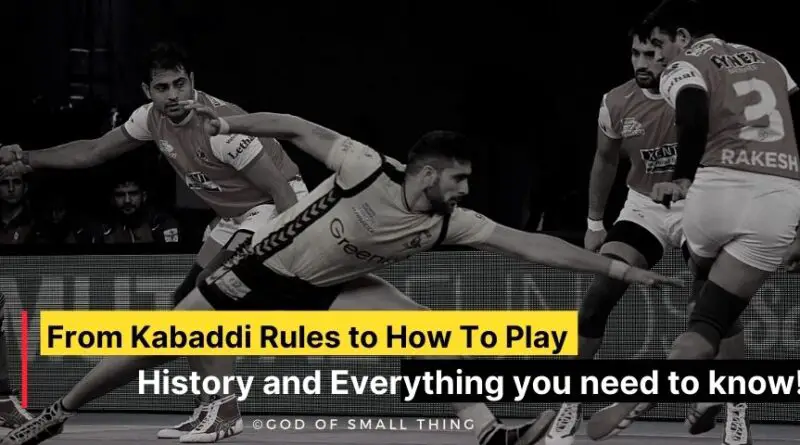From Kabaddi Rules to How To Play|History and Everything you need to know!
Greetings from the fascinating world of Kabaddi! Kabaddi, a sport that combines physical prowess, strategic thinking, and astonishing speed, has captured the hearts of millions of people all over the world. We go into the heart of this action-packed game in this guide, covering everything from its modest beginnings to its ascent to fame on a worldwide scale. We’ll manoeuvre through the game’s rules, tactical subtlety, and players’ rigorous training regimens.
A physical team sport, kabaddi is. The sport, which has its roots in Tamil Nadu, India, is hugely popular throughout Asia’s southern region. In addition to being the state sport of Tamil Nadu, Andhra Pradesh, Bihar, Maharashtra, Punjab, and Telangana in India, kabaddi is the national sport of Bangladesh.
The Tamil term “kai-pidi,” which means to clasp hands, is the source of the English word “kabaddi.” However, the Northern region of the country may have seen a large expansion of the phrase. When it was practised at the 1936 Berlin Olympics, the sport gained recognition on a global scale. The All Indian Kabaddi Federation (AIKF), which was founded in 1950 and later reorganised as the Amateur Kabaddi Federation, was first introduced in the Indian National Games in Calcutta in 1938.
How to play Kabaddi?

Kabaddi is played between two teams of seven players each on a specially designated Kabaddi court, field or pitch. The players take turns raiding one another. Each team’s half of the field is divided into two halves. The midline, which divides the teams’ turfs, is the most crucial line in Kabaddi.
Marking of Lines
The outer lines, also known as boundary lines, are marked with coloured sand in the 10-metre playground. The 10-metre boundary line marks the location of the playing areas with a one-metre space on either side. A central line is painted in the centre of the court, dividing it into two equal pieces of 7 by 8 metres each, defining the boundaries of each team’s region. They are set up four metres apart on either side of the centre line. Bonus lines that are located one metre apart from the central line are drawn on either side of it.
- The rectangular playing field for professional men’s Kabaddi is 33 feet (10 metres) long and 43 feet (13 metres) broad.
Toss and Decide
The first team to go is decided by flipping a coin. Tossing can also be done using unbiased dice on occasion.
As we are talking about the rules of the Kabaddi in India. Here is the list of Pro Kabaddi Winners List all seasons (2014-2022) with Video Highlights.
Raiding
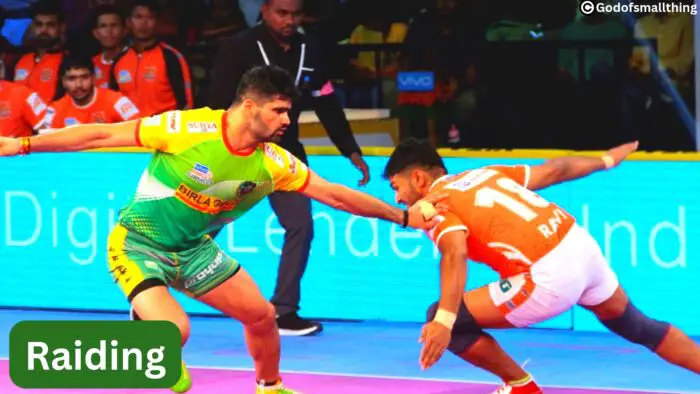
Following the toss, the team that won sends players—often referred to as raiders—into the areas of the opposing team. The raider’s main objective is to tag opponents and sprint back to his team’s side.
- The winning team is the one with the highest final score.
- If a game is tied after one half, there are two more five-minute halves.
- In the event of a tie after 50 minutes of play (20+20+5+5), the team that scored first will be crowned the winner.
Soon after crossing the midline, the raider must shout “Kabaddi” several times, and he must continue to do so until he is securely back in his zone. It’s important to note that the raider must never cease shouting “Kabaddi” during the raid. If he does, he should do so as soon as possible before going back to his zone. No points will be awarded to his side as a result, but his opponent’s team will receive a point for successfully protecting him.
Each opponent the raider tags is automatically eliminated. The winning side receives 1 point for each opponent tagged out if the raid is successful and the raider crosses the finish line without being tackled by the opposing squad. Important: According to Kabaddi rules, the raider must begin shouting “Kabaddi! Kabaddi!” “Kabaddi!!” continuously as soon as he enters the half of the field belonging to the other team.
To score points for the raiding squad (1 point for each opponent touched), the raider attempts to touch the opponents with his hand or foot while shouting constantly and therefore in one breath. And guess what? According to Kabaddi rules, a raid must be completed in 30 seconds or less. This means that the raider must be especially careful to avoid being tackled by the opposition.
Defence
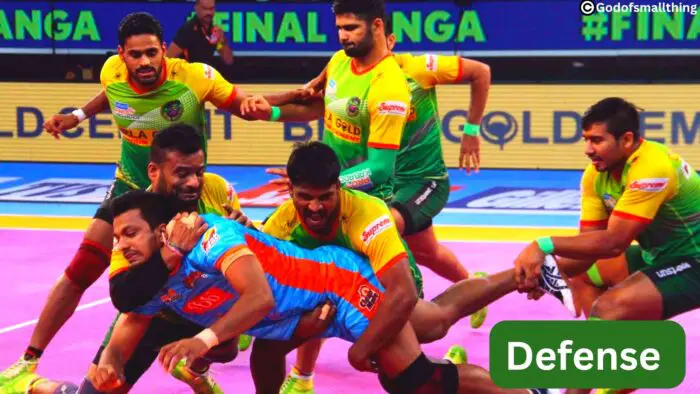
The enemy team will raid it if your team loses the toss. Your squad must then take the initiative and defend itself. You shouldn’t let the raider tag you. The raider’s team will receive a point for doing so. You should try to go as far away from the raider as you can before he can yell “Kabaddi” without being out of breath in order to avoid being tagged.
If he tags you, wait until the raider is out of breath, then grab him with your teammates before he crosses the centre line as soon as the raider finishes saying “kabaddi.” You cannot remove the raider’s clothing or hair. Instead, you can only grab him by a limb.
The Covers – main responsibility is to prevent their team’s top raiders from being tagged out. The waist hold and the double knee hold are their main techniques.
The Ins – job in Kabaddi is to construct a defensive chain by holding hands with the Corners, who will thus be better able to keep their balance.
The Corners – Because the raiders frequently attempt to tag these guys first, this Kabaddi position is crucial for the defensive team. A corner’s primary duties involve starting tackles, and they frequently use the thigh hold, dash, and ankle hold.
What positions are there in the Kabaddi Game?
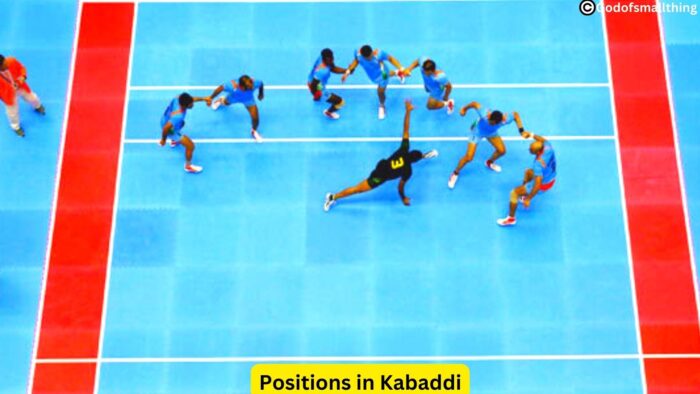
Although Kabaddi appears to be a solely physical sport, it is also incredibly tactical and strategic. Depending on the form of kabaddi in question, a different number of players may be involved in the action, which necessitates that the entire team work as a unit to fool the opposition. In standard style kabaddi, the seven players on the mat are positioned as right and left corners, right and left covers, and right-in and left-in positions, which help the cover defenders.
Raiders occupy the centre position, which is typically not filled by the defence unit. The amount of raiders and defenders required on the mat, however, is not specified because teams are free to use any combination they like.
- Right-corner: The right-corner spot is the farthest one from the playing field’s right side. The right corner is one of the main defenders in this position, and their main duty is to start tackles on the raider.
- Left-corner: The left-corner spot is the farthest one from the right side of the field of play. Similar to the right corner, the left corner is also a key position held by one of the team’s top defenders who is tasked with planning and carrying out successful tackles.
- Right cover: When the defensive unit executes a chain tackle, the right cover provides support. Additionally, the dash on the raider coming from the right side of the court is typically started by the right-cover defender.
- Left-cover: The left-cover defender plays a similar function to the right-cover defender and makes an attempt to dash on the raider coming from the left side of the court in addition to offering chain-like assistance to his corner.
- Right-in: This spot is next to the defender in the right corner. The right-in player’s job is to help the right corner and covers make a successful tackle attempt.
- Left-in: Next to the left corner defender is the left-in position. With the exception of where it is located on the left, this role is identical to the right-in position.
- Center: The centre position’s responsibility is to support the defensive unit. Most of the time, the team’s lead raider initiates a tackle rather than the player in the centre position, who typically plays a passive role in this.
As we are looking at the Legendary Kabaddi rules. Here is the list of 25+ Cricket Legends of India with Career Statistics and Best Performances.
Kabaddi Game Rules
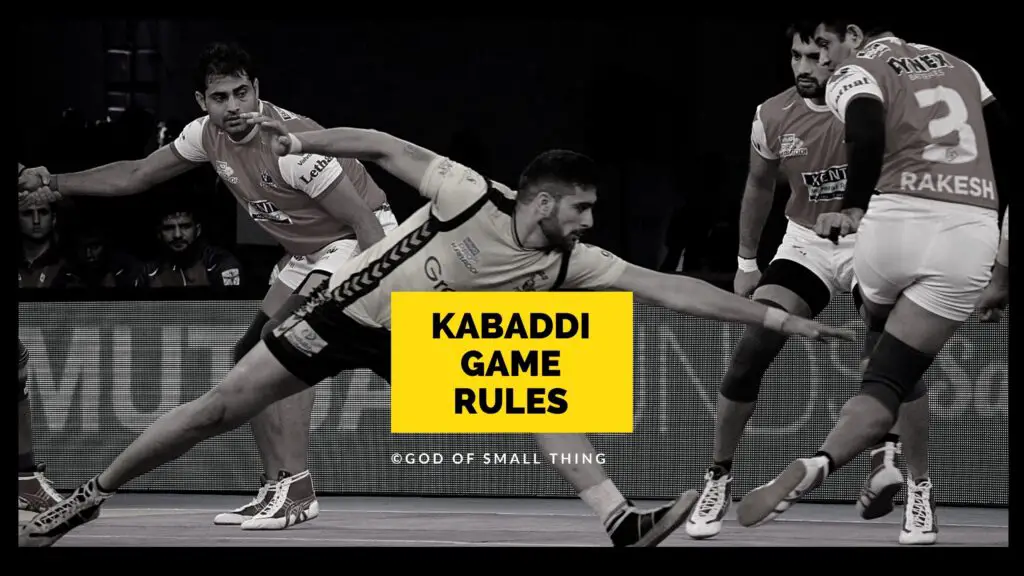
While the regulations for traditional kabaddi, which is played on mud in rural India. Vary, top leagues and competitions like Pro Kabaddi, the Kabaddi World Cup, and the Asian Games all adhere to a common format.
Kabaddi court: Size of playing area
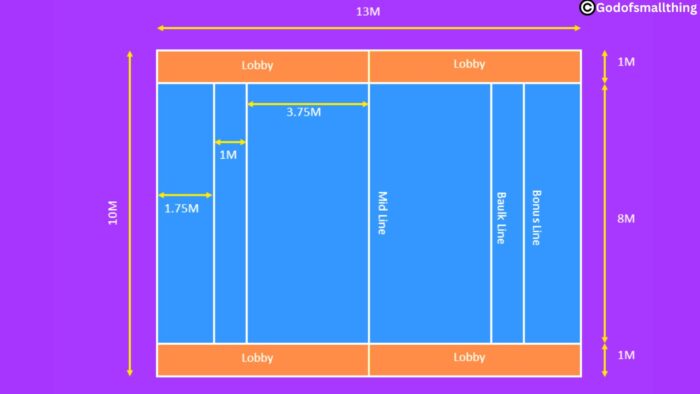
The size of a kabaddi court for competitive men’s kabaddi is 13 m by 10 m, per kabaddi rules. The court is somewhat smaller for women and measures 12m by 8m. The measurements, however, can be a little different for international and local contests. The midline, which divides the playing field into two halves, delineates the territory of each team. To start a raid, opposition raiders must cross the midline.
Baulk line
The baulk line runs 3.75 metres per side parallel to the midline. For a raid to be legal, the raider must cross the baulk line with one foot while keeping the other foot in the air. The raider cannot try to gain points until the raid has been approved.
Bonus line
The bonus line runs one metre parallel to the baulk line. However, the extra line is only in play if there are six or more defenders present on the mat. A raider must cross the bonus line with one foot on the ground and the other in the air to receive bonus points. A raider cannot retreat to his half with a successful bonus point attempt until he completes this.
Lobby
The rectangular, multicoloured space on each side of the court is the foyer. Only when raiders and defenders have made contact does this area become active? If there is contact, the raider can enter the lobby and use it as cover for his escape. And the defenders can use the same manoeuvre to stop the fleeing attacker. Players will be forced to leave the mat and stay on the bench until they are revived if they enter the lobby without making any contact.
Duration of a kabaddi match
A kabaddi match lasts for forty minutes. Each half lasts for 20 minutes, and at halftime, the teams trade sides. However, in a knockout match, if the score is tied, an additional seven minutes will be added to determine the winner. There is a one-minute pause in between each of the two three-minute halves of the seven minutes. Golden Raid is used to decide the match if there is still a tie after extra time.
Golden Raid
A new toss will be held prior to the Golden Raid, and the team that wins it will have the opportunity to raid. The baulk line will then serve as the bonus line, with each team fielding seven players. Along with the touches the player takes on the defenders, the raiding team will receive added points if the player crosses the line. If the player who launches the raid first scores even one point, his team triumphs.
Only points scored during the Golden Raid are tallied; the out and resurrection rules do not apply. In the event of a temporary player suspension during the tiebreaker, that side will play with fewer players. These players will be included while calculating bonus points. The outcome of this game will be decided by the flip of a coin if the score is still tied after both sides have attempted Golden Raids.
How many players in Kabaddi
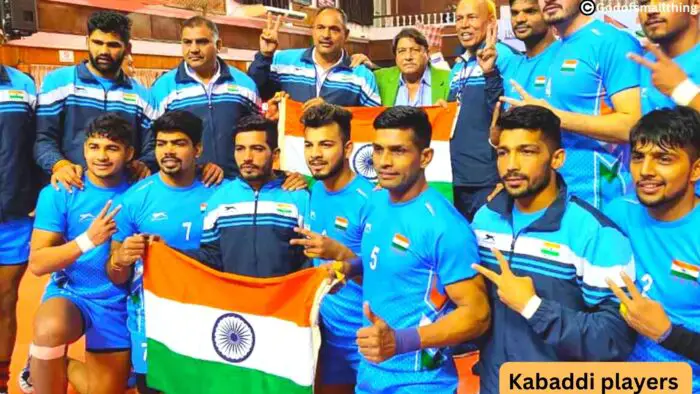
There are seven players on the mat for each team, plus five replacements. During the course of the game, a side may substitute a maximum of five times.
Kabaddi point scoring system
To successfully score a point, a raider must touch a defender in the other team’s half. And then return to his own half without incident. If the raider successfully returns to his half after earning a touch point, each player he touches is counted as a single point and must leave the mat.
In addition, for the attack to be successful, the raider must continuously sing the term “kabaddi.” In addition to earning bonus points for successfully crossing the bonus line with one foot in the air and the other across the line. While six or more defenders are on the mat, a raider has a maximum of 30 seconds to accomplish a raid.
The defending team scores a point and the raider is ruled out. If the defenders are successful in stopping the raider before he crosses the midline. A squad can restore their players in the same order as their dismissal with every raid point they earn.
Empty raid
A raid is considered to be empty if the raider doesn’t score any points from it.
Do-or-die raid
A do-or-die raid is one that comes after two empty raids. The raider must score a point; otherwise, he is eliminated.
All-out
A team receives an extra point (2 in Pro Kabaddi) when they are successful in removing every opponent from the game. After an all-out, all seven players from both sides, regardless of their dismissal order, return to the playing area.
Super Raid
A Super Raid occurs when a raider successfully touches three or more defenders in a single raid. A Super Raid is also considered to include a bonus point and the dismissal of two defenders.
Super Tackle
A Super Tackle occurs when the opposing team successfully tackles a raider while having three or fewer defenders on the ground. For each Super Tackle, teams are awarded an additional point.
Pro Kabaddi Rules

The Pro Kabaddi League’s ninth season features new teams, new obstacles to overcome, and new changes to the playing field. After the covid-19 pandemic, fans have returned to stadiums for the first time, and the changes to the playing rules promise to improve the spectator experience and give teams more tactical help during matches.
Lobby rule amended
The defender who follows the raider into the lobby as well as the raider who enters the lobby without touching any defenders were both considered to be out under the prior rules. In contrast to prior seasons, the defender who follows the raider into the lobby before being touched by the raider will no longer be considered to be out under the new rules.
A larger squad is allowed for Matchday
After the new rule’s implementation, a team’s match-day squad can only have a maximum of 14 players. A 12-player squad was previously permitted.
Permitted substitutions increase
This season, teams are permitted up to a total of eight substitutions, including one during the strategic time-out, as opposed to the five substitutions allowed during the game and one at halftime.
Technical Point
A technical point is awarded for the following reasons and is given to the team instead of either raider or defender:
- When a raid is active, coaching by a player or coach.
- During a raid, if a player leaves their area before coming into contact with an enemy.
Super Raid
A raid is referred to as a Super Raid if the raider scores three or more points (which may include touch, bonus, or technical points) for his team in a single raid.
As we are talking about the important and basic rules in the Kabaddi of India. Here is the List of Top 50 most famous sports personalities in India – The Gems of Indian Sports.
Do-Or-Die Raid
The subsequent raid is referred to as a Do-Or-Die Raid if a team engages in two consecutive empty raids (raids that yield no points for either team). This raid requires the raiding team to make a point, or else the raider will be eliminated even if he is not tackled.
Super 10
A Super 10 occurs when a raider earns ten raid points (touch and bonus points) in a single game.
Super Tackle
When a raider is successfully tackled, the defensive side receives two points rather than one if there are three or fewer players on the mat for the opposing team.
High Five
A defensive player is said to have a “High Five” if they accumulate five tackle points (including super tackle points) in a single game.
Double
The achievement is known as a Double if a player (often an all-arounder) receives a Super 10 and a High Five in the same game.
Scoring System
Teams receive five points for victories and three points for ties. A team receives one point if it loses by less than a seven-point deficit.
Review System
Each team is typically permitted one review each game during the league round. Teams receive one review each half (a total of two) for the knockout rounds.
List of Kabaddi international teams

Another sport that dominates the league, in addition to football and cricket, is Kabaddi. Both men and women like playing this game in India. One needs strength, courage, and power to play this game and win. They also need to employ the appropriate strategies to defeat their opponents. This game has its origins in Tamil Nadu and is quite well-liked there. This game is becoming more and more well-liked.
| 1 | INDIA |
| 2 | IRAN |
| 3 | PAKISTAN |
| 4 | SOUTH KOREA |
| 5 | BANGLADESH |
| 6 | SRI LANKA |
| 7 | KENYA |
| 8 | NEPAL |
| 9 | THAILAND |
| 10 | INDONESIA |
| 11 | IRAQ |
| 12 | POLAND |
| 13 | JAPAN |
| 14 | MALAYSIA |
| 15 | GREAT BRITAIN |
| 16 | CHINESE TAIPEI |
| 17 | ITALY |
| 18 | NEW ZEALAND |
| 19 | NORWAY |
| 20 | AUSTRALIA |
| 21 | NETHERLANDS |
| 22 | HONG KONG |
| 23 | GERMANY |
| 24 | TURKMENISTAN |
| 25 | AFGHANISTAN |
| 26 | ARGENTINA |
| 27 | USA |
As we are talking about the best Kabaddi international team. Here is the list of Legends of Indian Hockey: 30+ Best Hockey Players of India with Career Stats.
Some Frequently Asked Questions
6 Basic Kabaddi rules and regulations
Playing area (Kabaddi ground measurement)
· Kabaddi ground measurement and the playing surface measures 13 * 10 meters.
· The playing area is divided into two halves.
· One team occupies each half. Also, there are wide ranges of surfaces from a clay court to spare ground.
· There are two teams that contest a match.
· Every team has a total of seven players and both teams lodge opposite halves of the field.
Teams
· Each side gets an alternate turn to send any one player to the opponent’s side. This player is known as the raider whereas each player on the opposing team is called a defender.
· The winner of the match is the team that manages to score the most points.
Objectives for Raiders
· This is the first and foremost rule. The raiders should take a breath and entone ‘kabaddi kabaddi’ without any break.
· The raider should tag a member of the opposite team and return to his half.
· He/she is ‘out’ when a player breaks the breath or fails in tagging the opponent team member.
· 30 seconds are available for each raid.
· If the raider fails to reach his half within time, he is out and the opposite team gets one point.
· If the raider crosses the check line with one foot with the other one in the air, when the defending team has 6 or 7 defenders, he or she gets a bonus.
Objectives for Defenders
· The role of a tagged player is to catch the raider and prevent him/her from reaching half of the field.
· One point is awarded when the defender tackles to prevent the raider from going back.
· Defenders must be cautious enough not to cross the centerline of the field known as ‘the lobby’ while trying to catch the defender as doing this can lead to a foul.
· Defenders should not grab or hold raiders by their clothes, hair, or any part of their body other than their limbs and torso.
Officials and Kabaddi match time duration
· A kabaddi match typically runs for 40 minutes (20 minutes each). Teams change sides after halftime.
· The officials involved in kabaddi consist of a referee, two umpires, a scorer, and one assistant scorer.
Bonus points
· Six players must be present on the court.
· Raider gets one point when he crosses the bonus line.
· The defending team gets one point when they tackle the raider.
· There is no revival for bonus points.
1: Two Teams of Seven Players
2: Each Match bConsists of Two Halves
3: Points gets Score by Raiding the Opposition’s Side
4: A Successful Raid is Worth Two Points
5: A Player is Out if They are Caught During a Raid
6: A Player is Out if They Fail to Touch the Opposition
7: A Player is Out if They Cross the Centre Line
8: A Player is Out if They Hold Their breath
9: A Player is Out if They Leave the Field of Play
10: The First Team to Score Seven Points Wins
The incredibly unusual sport of Kabaddi has been practised for generations. Kabaddi’s gear is as distinctive as the game itself.
– Kabaddi Mat
– Kabaddi Court
– Knee Caps and Elbow Guards
– Ankle Caps and Knee Pads
– Kabaddi Shoes
– Kabaddi Dress
When a raider succeeds in collecting 10 points or more, it is known as a Super 10. Only a handful of raiders have routinely broken the Super 10-mark since the league’s debut in 2014, cementing their places in history.
The Pro Kabaddi player with the most Super 10s is Pardeep Narwal (79). Since Season 3, the Dubki King, who averages over 10 points per match, has been able to score at least five Super 10s in each tournament.
The green card serves as a first caution against breaking any rules.
The Yellow Card denotes a two-minute match suspension for breaking any rule and also awards the opposing team one technical point.
The Red Card denotes a suspension for the remainder of the game and awards the opposing side one technical point.
In order to earn a point by contacting any of the guards on the mat, a raider must cross the midline and join the opposing side from his side of the court. Cant- As soon as the raider enters the half of the resistance, he must begin saying “Kabaddi.” He is said to have canted out and the opposition scores a point if he stops speaking. The player must cross his foot once inside the opposition half of the baulk line to complete his raid. A 30-second time limit applies to the raid. The other team get one point if the raider is sent out before reaching his half within the allotted time.
In India, kabaddi has a history that dates back almost 4,000 years. Even though it has long-standing roots in the nation, its reach hasn’t been as wide. According to legend, kabaddi began as a way for ancient soldiers to practise their fighting skills before fights and conflicts.
According to the World Kabaddi Federation, “it is believed that kabaddi was invented to develop defensive responses by an individual against group attacks and group’s responses to an individual attack.” Kabaddi, a sport with a long history in India, is even mentioned in Hindu mythology.
According to the Sanskrit epic Mahabharata, Lord Krishna, who loved the game of kabaddi, taught the Pandava warrior Arjuna how to play the game.
The sport of kabaddi has two main divisions: “Punjabi kabaddi,” also known as “circle styles,” includes traditional variations played on an outdoor circular field, while “standard style,” which is played on an indoor rectangular court, is the division used in important professional leagues as well as international competitions like the Asian Games.
One team raids the opposing team’s half to begin a kabaddi match. Any one attacking team member, known as the raider, enters the opposing team’s half while chanting the term “kabaddi,” also known as canting, during a raid.
A player must continuously chant “kabaddi” while moving to the opponent’s half in one breath. Cant is another name for that chant. Lona: When a team manages to eliminate the whole opposition team, it earns two extra points.
The raider must yell “kabaddi” aloud when conducting a raid to signal the referees that they are conducting the raid while exhaling only once. There is a 30-second time limit for each raid. Every defender that is tagged earns the raider one point; tags can be performed with either the raider’s hand or foot.
If a player or team commits any of the following violations or fouls, the referee and the umpires have the authority to warn, declare a technical foul against, temporarily suspend or disqualify the offending player or team from the game:
– Persistently protesting or objecting to the official’s decision, thereby disrupting the match.
– Making derogatory remarks about the officials & their actions, thereby trying to influence their decision
– Showing overt aggression towards the referee or umpire demanding a favourable decision.
– Stifle a raider by shutting his mouth or throat in any way
– Violent tackling leading to injuries being sustained the by opponent raider
– Taking more than 5 seconds to start the raid unless specified in the rules
– Hold the raider with the help of scissors operated by legs
– Coaching from outside by the coaches and the players
– Preventing the raider from taking his turn to raid

